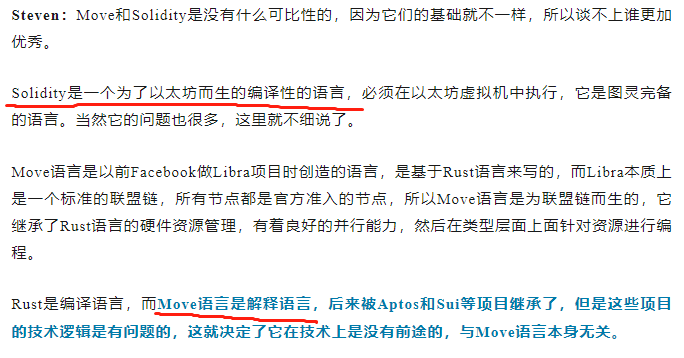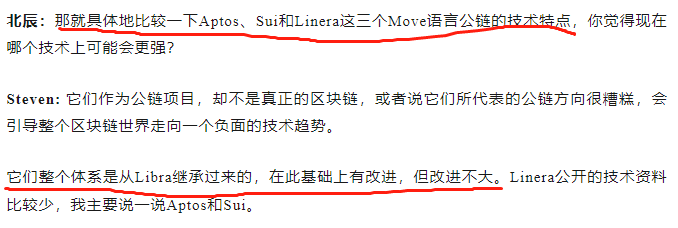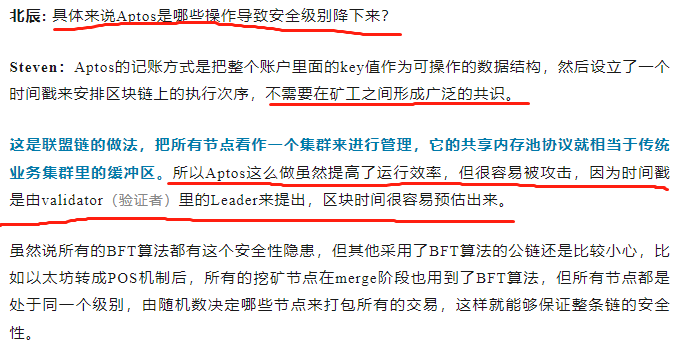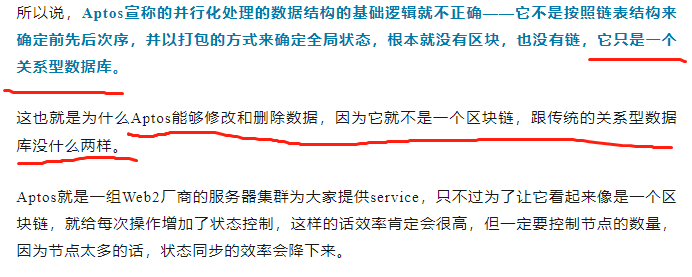Refuting the Claim that MOVE Blockchain is a Consortium Chain from 12 Perspectives
Disproving MOVE Blockchain's Consortium Chain Claim from 12 PerspectivesSource: “Counterattack! Senior Developers Refute Some Criticisms of Move-based Public Chains”
Author: Faust
Interviewees:
- Wubuku – founder of the low-code Dapp development platform dddappp
- Nanne2022 – senior Move ecosystem developer
- Zhou Qi – founder of the Ethereum ecosystem storage project EthStorage
- Li – senior Move ecosystem developer
- Jolestar – founder of the Layer2 project Rooch that supports Move
- eternal – Move community member
Background: On June 21, 2023, an article entitled “Technology Going Backwards? Aptos and Sui Are Actually Consortium Chains, and Their Survival Depends on Capital’s Patience” was published by a media outlet called “Sharp Whistle.” The article mainly concerns an interview conducted by the author, Beichen, with a communications engineer named Steven who is suspected to be from the chip giant Qualcomm, and makes many criticisms of Aptos and Sui. The article claims that Steven is a technical expert who frequently makes outrageous statements about blockchain, and that Sui is not the right direction for blockchain, and that both Aptos and Sui use consortium chain technology.
- Can Web3 games escape the SEC’s sword dance?
- DeFi “cleaner” Poop: Recycle users’ worthless coins and aim to achieve “only rise and no fall”
- Can OP Stack, the competitor launched by zkSync, win the battle of L2 scaling?
After the article was published, it sparked widespread dissemination and controversy in some Web3 communities. Many industry technical personnel, including the Ethereum community and the Move community, criticized the article.
In the spirit of seeking truth from facts, we conducted interviews with many technical experts in the industry to discuss the 12 controversial points in the article “Technology Going Backwards? Aptos and Sui Are Actually Consortium Chains, and Their Survival Depends on Capital’s Patience.”
1. Regarding the article that criticizes Move-based public chains, the phrase “all Move-based public chains are essentially consortium chains” is repeatedly mentioned in the title and conclusion.

Nanne2022: There are multiple indicators to distinguish between consortium chains and public chains, and the most important one is the entry threshold for nodes. Consortium chain nodes need official permission to enter the network, and users are not allowed to privately build full nodes that synchronize data. Data from a consortium chain can only be synchronized within the nodes of the chain, and if external parties want to obtain the data, they can only do so through the interface provided by the consortium chain’s internal nodes.
Public chain’s full nodes have no admission threshold. Validator nodes that pledge sufficient assets can enter.
In addition, the technology can distinguish between a public chain and a consortium chain, such as consensus and network communication. The design principles for public chains and consortium chains are different. Consortium chains only consider a fixed number of nodes, and the design principle is that the nodes are officially licensed, not permissionless. This makes the technical implementation of consortium chains relatively simple. In fact, Aptos and Sui are not using consortium chain technology, but public chain technology.
What people really criticize about Aptos and Sui is that they are not decentralized enough (compared to Ethereum), and that Sui’s official has the ability to control SUI liquidity on the secondary market.
Note: Currently, the vast majority of public chains, including Aptos and Sui, have no admission threshold for full nodes. Aptos’s consensus node can run by pledging 1 million APT, and Sui’s consensus node requires pledging 30 million SUI, both of which do not require official permission.
2. About the article’s claim at the beginning that Aptos and Sui actually have no blocks and no chain.

Wubuku: First of all, Aptos has blocks, as can be seen from its Node API documentation.

Secondly, Sui does not have the concept of blocks because it uses a DAG structure for transaction data. However, the narrow definition of “blockchain” is not so important. What is needed to achieve the Web3 vision is a “decentralized ledger,” not a specific data structure.
3. About the article’s author’s belief that “people in the Web3 circle are quite ignorant, for example, after Dfinity (ICP) appeared, many people were excited and thought it had a great narrative, could solve many problems, but in fact, it’s just a story about cloud native, and Microsoft and IBM have been doing it for years.”

Jolestar: The construction path of ICP is indeed problematic. But this author should feel that the road to “decentralized cloud computing” is not right, but Web3 is decentralized cloud native.
4. Regarding the guest Steven’s opinion that “since Ethereum, there hasn’t been any new technological paradigm.”

Zhou Qi: If you’re talking about the earliest Ethereum, in fact, it and other technological paradigms have changed very quickly. ZK, DA, Verkle Tree, interactive fraud proof, the earliest initiators of these technological paradigms were not the Ethereum Foundation, but they were quickly adopted and absorbed by Ethereum.
For example, Ethereum borrowed from Celestia in terms of DA, and from Cosmos’ Tendermint in terms of PoS consensus protocol. ZK is not considered Ethereum’s own technology, but the Ethereum Foundation has spent a lot of effort promoting the concept of ZK.
Moreover, Move language is also an innovation in technological paradigms. The paradigm innovation of Algorand and Cardano on POS is also important, but it has not yet undergone large-scale testing.
5. Regarding Steven’s opinion that “Solidity is a compiled language, and Move is an interpreted language.”

Nanne2022: If you want to use “compiled” and “interpreted” to divide them, Solidity and Move should be classified into the same category.
In the traditional sense, compiled languages compile code into forms that are closer to the machine’s lower level, such as assembly language, and are then linked and run by the machine. Interpreted languages, on the other hand, compile the code into some higher-level bytecode, which is then directly interpreted and run by the bytecode interpreter, such as Ruby, Python.
If viewed from this perspective, both Solidity and Move are first compiled into bytecode that the virtual machine can interpret, and then output as machine code that the underlying hardware can understand when executed. Regardless of how you understand interpreted and compiled, Solidity and Move belong to the same category.
eternal: Contracts written in Solidity and Move are compiled locally on the host where the IDE platform for developing the contract is located, and when uploaded to the chain, only bytecode is stored. From the perspective of the entire process of the language being handled by the compiler and interpreter, there is no essential difference between Solidity and Move.
6. Regarding Steven’s opinion, “Move language was created by the former Facebook consortium project Libra, based on Rust language, and is designed for consortium chains. Move inherits Rust’s hardware resource management and has good parallel capabilities.”

Wubuku: First of all, Starcoin uses Move as a contract development language, adopts a more classical POW consensus algorithm, and has no relationship with consortium chains. Then, Rust is a language designed for system programming, and Move is a language redesigned for “smart contract development”. The so-called “Move inherits Rust’s hardware resource management” is actually irrelevant. Moreover, it cannot be said that “Move inherits Rust’s hardware resource management capabilities” just because Move’s “resource-oriented programming” is inspired to some extent by Rust’s ownership mechanism (used to achieve memory safety).
eternal: Whether it’s Solidity or Move contract code, it’s ultimately run in a sandboxed virtual machine, and the underlying hardware resources are not perceived at all. Move does not have the “hardware resource management capabilities” of Rust. In addition, there are now Ethereum Layer2s such as Rooch and ZkMove that support Move language, and writing Move contracts does not have to be on Aptos and Sui.
7. Regarding Steven’s opinion that “Move is not a good language because it cannot be used without projects such as Aptos and Sui.”

Nanne2022: This is completely true for Solidity as well. If Solidity is separated from chains that support EVM, it cannot be used. “XXX is not a good language because if you separate it from the XXX ecosystem, the XXX language cannot be used.” This applies to many programming languages.
eternal: Steven says this mainly because Solidity and Move require a dedicated virtual machine to execute, which requires a dedicated program, but Java, which dominates the entire Internet development field, also requires a dedicated virtual machine. If it were placed in the late 1990s when Java was just launched, someone would say, “Java is not a good language because it cannot be used without the JVM ecosystem.”
8. Regarding Steven’s remarks, “The entire system of Aptos and Sui is inherited from Libra, with some improvements, but the improvements are not significant.”

Wubuku: Aptos was launched earlier than the mainnet, and it is actually closer to Starcoin, but its consensus is more “environmentally friendly” PoS.
Sui’s improvements are actually quite radical. In terms of the state storage model of the public chain/network, Sui Move has undergone a quite thorough rewrite, abandoning the account storage model of Starcoin and Aptos and adopting an object storage model. Move developers who have worked on applications on these different public chains must have a deep understanding of the obvious differences between them. We cannot simply assume that they are relying on their Libra background.
9. Regarding Steven’s remarks, “Libra is essentially a relational database with a version number. Each transaction updates the ledger state, which is completely different from traditional blockchain. The blockchain ledger only adds fields and does not modify existing ones. This method of global state control is only suitable for alliance chains and not for public chains.”

Li: Blockchain is essentially a verifiable Key-Value database, and there is no need to compare it with relational databases.
Zhou Qi: Ethereum’s StateTree ledger status model can modify existing data and supports versioned Key-Value storage models with addition, deletion, modification, and querying capabilities. Moreover, other traditional blockchain ledgers can also delete data, such as utxo on the Bitcoin chain that is used up and deleted.
Jolestar: I feel that Steven’s understanding of the StateTree status tree is not accurate.
10. Regarding Steven’s remarks, “Aptos sets a timestamp to arrange the execution order on the blockchain, without the need to form a broad consensus among miners. This approach is vulnerable to attacks… Block time is easy to predict, leading to a decrease in Aptos’ security level.”

Li: Aptos’ accounting model is basically the same as Ethereum’s account model, and the BFT consensus used is not sequenced by timestamps. The so-called “block time” can be estimated, and it will only expose different leaders at different times. In theory, there may be hidden dangers of being attacked by DDoS. However, this belongs to the problem of availability, and has no connection with security. Moreover, the leader exposure time of Aptos at each point in time is only a few tens of seconds, and the leader is rotated every second.
eternal: For both blocks and transactions on Aptos, at least 2/3 of the miners (validators) need to reach consensus, and it is not “necessary to form a wide consensus among miners.” It’s just that the transaction data on Aptos is consensused, and it is completed before being packaged into a block, and the block does not need to contain complete transaction data, just a summary is enough.
Zhou Qi: The block producer at a certain point in time can be estimated, and in theory, it can be DDoSed. But secret leader election can solve this problem.
11. Regarding Steven’s view that “Aptos is just a relational database… there is no difference from traditional relational databases.”

Wubuku: As a senior CRUD boy who has been doing traditional enterprise applications and Internet applications for more than 20 years, the experience provided by Aptos and “relational databases” is worlds apart.
Li: The essence of blockchain is a verifiable key-value database, and there is no need to differentiate it from relational databases.
12. Regarding Steven’s view that “Sui does not need all nodes to reach consensus…
Sui divides transactions into simple transactions and complex transactions. Simple transactions end with a signature, and complex transactions only need BFT consensus. Any transaction that can be submitted can theoretically be independently verified… Sui directly abandons the most basic consensus of blockchain.”

Nanne2022: The meaning of consensus is that most nodes in the system confirm a message and can reach a steady state for a certain period of time (that is, continue to process subsequent messages). For transactions in Sui, whether they are simple or complex, they need to collect signatures from all nodes. Simple transactions will complete consensus when more than 2/3 of the nodes respond, and complex transactions will enter the next consensus process.
Simple transactions do not conflict with other transactions and can naturally be parallelized. Therefore, simple transactions and complex transactions can be separated for consensus verification, which can speed up the process.
As for why Sui can achieve fast transaction confirmation, it also has a lot to do with the Narwhal memory pool protocol it adopts. Narwhal ensures that the messages to be agreed upon can be obtained directly locally, allowing nodes to complete consensus directly locally without the need to obtain messages similar to blocks from the network.
Wubuku: Sui is quite special in that it can use different consensus methods for simple and complex transactions, which can be traced back to Sui’s object model.
Sui’s object model consists of two types: Owned Objects and Shared Objects. Among them, Owned Objects are similar to Bitcoin’s UTXO, but they are an “enhanced version of UTXO”. Compared to this, Shared Objects are closer to Ethereum contract accounts that process global data.
Sui’s simple transactions often only involve Owned Objects, which are similar to UTXOs, can only be operated by their Owner, have version numbers, and naturally support parallel processing. Therefore, simple transactions that only involve Owned Objects can take a shortcut in consensus verification and do not need to be sorted with other transactions.
We will continue to update Blocking; if you have any questions or suggestions, please contact us!
Was this article helpful?
93 out of 132 found this helpful
Related articles
- Deep | Former Harmony Employee Reveals Management Chaos Behind the Struggling Public Chain
- Can OP Stack, the competitor launched by zkSync, win the L2 scaling battle?
- Introduction to ZK Stack by Matter-Labs – Building a modular framework for ZK-powered sovereign chains
- Application of liquidity in PoS: Examples of Berachain, Tenet, and Mangate
- Inventory of 11 Celebrity Cryptocurrency Scammers: Jake Blockingul, Floyd Mayweather, John Wall…
- Application of Liquidity in PoS: Examples from Berachain, Tenet, and Mangate
- Interpretation of How to Earn Profits with PENDLE






